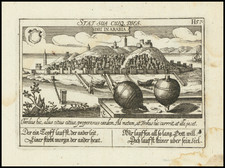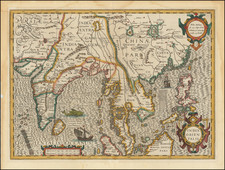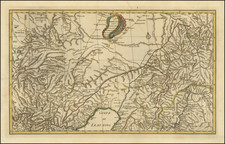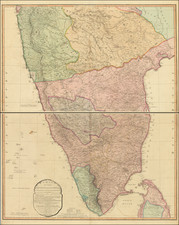Produced by the Royal Geographical Society, in cooperation with the Mount Everest Foundation, the map of the Mount Everest region is a utilitarian representation of the terrain. The map combines a collection of historical surveys, offering an insightful view into one of the world's most challenging geographical landscapes.
At the heart of the map are contour lines, mapping out the rise and fall of the land with clear demarcations. Major geographical features are well-represented, with symbols and markers indicating glaciers, moraines, passes, mountains, and more. Tracks are also indicated, showing the pathways navigated by explorers throughout history.
An essential part of the map's design is its use of altitude reference, taking Mount Everest's height of 29028 feet (8848 m.) as the central point. This feature allows for an accurate display of the region's elevations, offering a clear visual guide to the drastic altitude changes in the area.
The map also includes a helpful glossary of Tibetan and English terms, aiding in the interpretation of local geographical features and placenames. This feature underscores the map's emphasis on utility and education.
The map employs the following sources:
Absolutely, let's delve into each source of the map in chronological order, providing some historical context for each:
-
"Mount Everest and the Group of Chomo Lungma 1:63,360" - Major E.O. Wheeler, R.E. 1921. R.G.S. and Alpine Club 1925. A photographic survey conducted by Major Edward Oliver Wheeler, a prominent Canadian surveyor and mountaineer who was part of the initial reconnaissance expeditions to Everest in the early 20th century. Wheeler's work provided crucial insights into the structure and layout of the Everest region.
-
"Mount Everest and Environs 1:126,720" - Survey of India, 1930. The Survey of India, established in 1767, is the oldest scientific department in India and had a long history of mapping the subcontinent. This particular survey played a significant role in informing the world about the geography surrounding Mount Everest.
-
"The Northern Face of Mount Everest" - Photographic survey by Michael Spender, 1935. R.G.S. 1936. Spender, an English geographer and explorer, provided detailed information on the Northern face of Mount Everest through his photographic surveys.
-
Photogrammetric survey - Michael Spender, 1939. An extension of Spender's previous work, this survey further refined our understanding of the region, although it was not published.
-
"The Southern Face and Region South of Mount Everest 1:50,000" - H. F. Milne, R.G.S. 1952. Drawn from photographs, including those of the Mount Everest Flight in 1933, this survey focused on the southern face and areas south of Mount Everest.
-
"New Zealand Alpine Club Expedition 1954 and Chamlang Survey Expedition 1955" - Norman Hardie. These expeditions resulted in detailed maps of the region based on photographs taken during the expeditions, providing new perspectives on the terrain.
-
"Esquisse Topographique de la Région de l'Everest et du Makalu 1:50,000" - Expéditions Françaises à l'Himalaya, 1954-55. This French expedition offered further detailed topographical information of the Everest and Makalu regions.
-
"Mahalangur Himal: Chomolongma- Mount Everest 1: 25,000" - Photogrammetric survey by Erwin Schneider, International Himalayan Expedition, 1955. Schneider, an Austrian mountaineer and cartographer, brought further detail and accuracy to the mapping of the Everest region.
-
"Merseyside Himalayan Expedition 1955" - An unpublished map from this British expedition added to the wealth of data about the region.
-
"Survey of India 1:253,440" - Sheets 7IL (1932) 71P (1929) 721 (1932) and 72M (1930). The Survey of India's detailed maps were a crucial source of broad-scale information about the region.
These diverse sources contribute to the Royal Geographical Society's Map of the Mount Everest region, making it a compendium of early to mid-20th-century surveys of the region, each with its unique historical significance. The map is, therefore, not just a geographical tool but a document chronicling the history of human exploration of the Everest region.













![Carte de la Turquie, de l'Arabie et de la Perse, dressée sur les mémoires les plus récents rectifiée par les observations de Messieurs de l'Académie Royale des Sciences par G. de L'Isle, géographe. [Map of Turkey, Arabia, and Persia, drawn up based on the most recent memoirs and corrected by the observations of the gentlemen of the Royal Academy of Sciences by G. de L'Isle, geographer.]](https://storage.googleapis.com/raremaps/img/small/94075.jpg)
